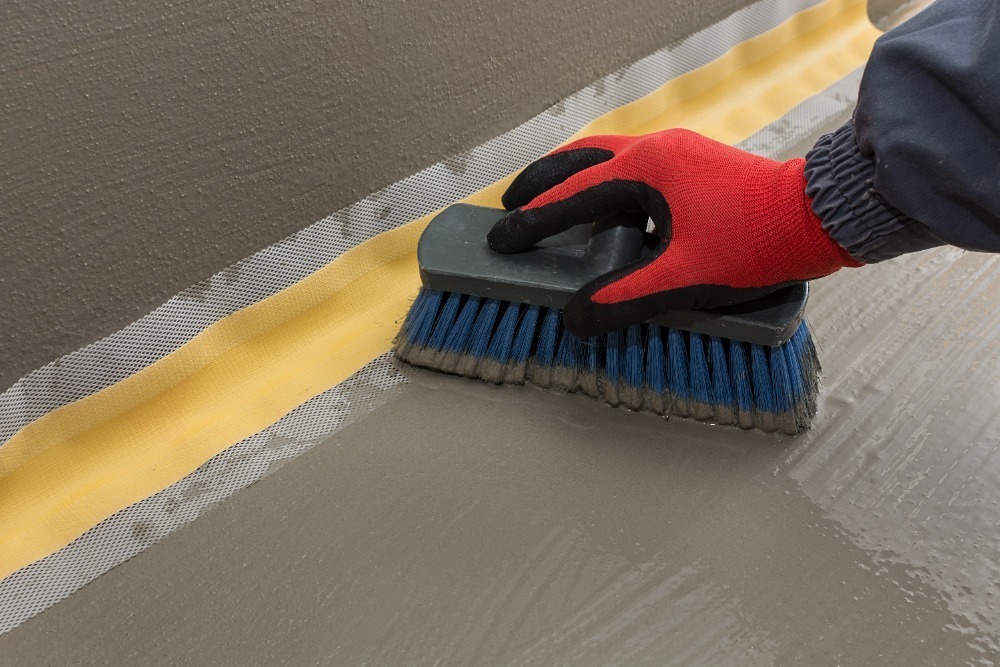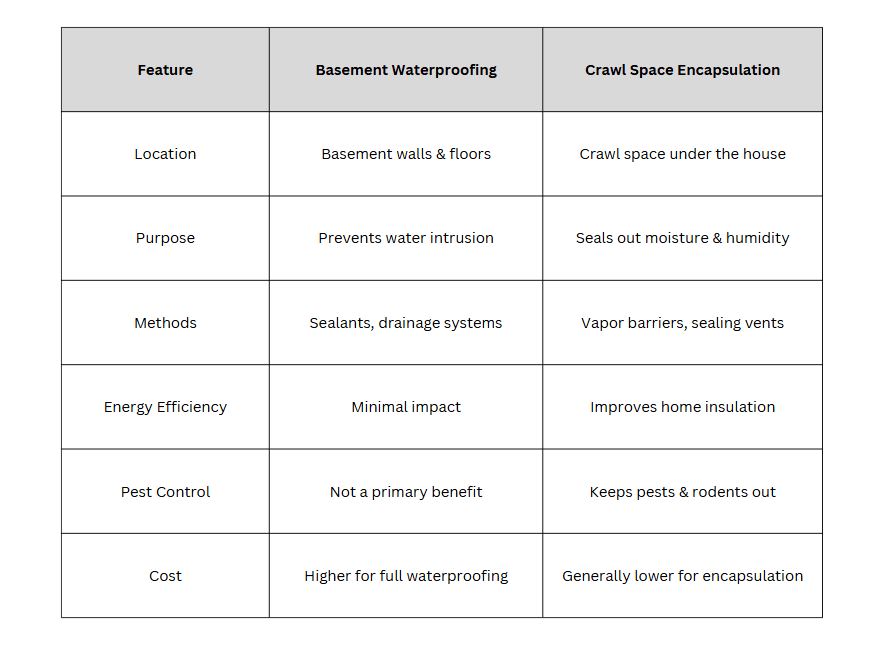Eastern North Carolina Important: COVID-19 Announcement.

Basements and crawl spaces are prone to water damage, making moisture control a critical aspect of home maintenance. Many homeowners confuse waterproofing and encapsulation, but these are two distinct approaches with different benefits.
Understanding the difference between these two methods can help you choose the right solution to protect your home’s foundation.
Basements and crawl spaces play a crucial role in a home’s foundation, insulation, and storage capacity. However, because these areas are below ground level, they are highly vulnerable to moisture intrusion, temperature fluctuations, and structural damage.
A well-maintained basement provides extra living space, energy efficiency, and structural support, but without proper waterproofing, it can become damp, musty, and prone to mold growth. Similarly, a crawl space serves as a barrier between your home and the ground, regulating airflow and insulation. But if it is not encapsulated, it can allow excess moisture, pests, and humidity, which can weaken your home’s foundation over time.
By implementing effective waterproofing or encapsulation, homeowners can prevent costly foundation damage, improve air quality, and maintain energy efficiency. Choosing the right solution depends on the moisture risks your home faces and your long-term protection goals.
Basement waterproofing is the process of preventing water from penetrating your basement walls and floors. It involves applying sealants, installing drainage systems, and repairing foundation cracks to keep moisture out.
1. Interior Waterproofing – Installing a waterproof membrane or sealant on basement walls to block moisture.
2. Exterior Waterproofing – Applying a protective coating to the outside foundation walls to prevent water infiltration.
3. Drainage Systems – Installing a sump pump and drainage tiles to redirect excess water away from the foundation.
4. Foundation Crack Repair – Sealing foundation cracks to prevent water seepage and structural deterioration.
Waterproofing not only protects against immediate flooding risks but also extends the lifespan of your home’s foundation, keeping it safe, dry, and structurally sound for years to come.
Unlike basement waterproofing, crawl space encapsulation is a full-sealing process designed to block moisture, air, and pests from entering. This method is ideal for homes with high humidity problems or moisture-prone crawl spaces.
Crawl space encapsulation is a multi-step process designed to eliminate moisture intrusion, regulate humidity levels, and protect your home’s foundation. Unlike simple waterproofing, which only prevents surface water seepage, encapsulation creates a complete barrier against moisture, mold, and pests.
Before the encapsulation process begins, it’s essential to inspect the crawl space for existing issues. A professional contractor will:
Once the crawl space is prepared, the encapsulation process includes:
Once completed, crawl space encapsulation transforms a damp, musty, and pest-prone area into a clean, dry, and energy-efficient space. It also enhances indoor air quality, reduces heating and cooling costs, and extends the lifespan of your foundation.
While both methods protect against moisture, they serve different purposes:

Schedule a Free Consultation to determine the best moisture control solution for your home!
Crawlspace encapsulation offers numerous advantages that go beyond just moisture control. This method helps protect the structural integrity of your home, improves indoor air quality, and boosts energy efficiency. Here are some of the key benefits of choosing crawlspace encapsulation:
1. Improved Indoor Air Quality:
Encapsulating your crawl space helps eliminate mold, mildew, and allergens that can thrive in damp environments. By sealing off the area from excess moisture, encapsulation improves the air quality in your home, reducing the risk of respiratory issues and allergies, especially for those with sensitivities.
2. Energy Savings:
A sealed crawl space reduces air leakage between your crawl space and the living areas above. This prevents cold drafts in winter and heat infiltration in summer, leading to more efficient heating and cooling. As a result, you can lower your energy bills and create a more comfortable living environment year-round.
3. Protection Against Pests:
By sealing your crawl space from the outside, encapsulation prevents pests such as rodents, termites, and insects from entering. These pests can cause significant damage to your home’s structure, wiring, insulation, and wooden components. Encapsulation eliminates pest entry points, safeguarding your home.
4. Prevents Water Damage:
Encapsulation is especially effective in moisture-prone areas, as it blocks water and moisture from entering the crawl space. This process prevents water damage, wood rot, and foundation instability, which are often caused by high humidity or water intrusion.
5. Increase in Home Value:
A sealed crawl space is seen as a valuable home improvement. Not only does it enhance your home’s energy efficiency and indoor air quality, but it also increases your property value. Potential home buyers are attracted to homes with well-maintained foundations, as encapsulation helps protect your home from future damage.
6. Extends the Lifespan of Your Home:
Crawlspace encapsulation helps preserve the integrity of your foundation, wooden structures, and insulation by keeping moisture, pests, and dirt out. This leads to fewer repairs and increases the overall lifespan of your home.
Both basement waterproofing and crawl space encapsulation are effective moisture control methods, but they serve different functions. If your home is prone to flooding or water seepage, waterproofing is the best option. However, if your concern is humidity, mold, and energy efficiency, encapsulation is the ideal choice.
For the best results, consulting a professional is essential. Our experts at Atlantic Foundation & Crawl Space Repair will evaluate your home’s foundation, moisture levels, and structural integrity to recommend the best solution.
1. How do I know if I need crawl space encapsulation or waterproofing?
If your home has a basement with visible water leaks, standing water, or foundation cracks, basement waterproofing is the best option. However, if your home has a crawl space with high humidity, pest infestations, or mold growth, encapsulation is the ideal choice to seal and protect the area.
2. Does crawl space encapsulation prevent mold and moisture problems?
Yes! Crawl space encapsulation blocks moisture and humidity, which are the leading causes of mold growth, wood rot, and musty odors. By installing a vapor barrier, sealing vents, and using a dehumidifier, encapsulation eliminates the conditions that allow mold to thrive.
3.How long does basement waterproofing or crawl space encapsulation last?
Basement waterproofing can last 20+ years if properly maintained, while crawl space encapsulation can last a lifetime if the vapor barrier and insulation remain undamaged. Regular inspections and dehumidifier maintenance help extend their effectiveness.
4. Can crawl space encapsulation increase home value?
Absolutely! A properly encapsulated crawl space enhances indoor air quality, prevents moisture damage, and improves energy efficiency, making your home more attractive to buyers and increasing its market value.
5. Can I encapsulate my crawl space myself?
While DIY crawl space encapsulation is possible, professional installation is recommended for long-term effectiveness. Experts use high-quality vapor barriers, insulation, and sealing techniques to ensure maximum moisture protection and durability.
https://www.baycrawlspace.com/encapsulation-the-dos-and-donts-of-crawl-space-encapsulation/
https://crawlspacemedic.com/what-is-crawl-space-encapsulation/
https://armoredbasement.com/what-is-crawl-space-encapsulation-and-do-you-need-it/
https://www.hunker.com/13415131/advantages-and-disadvantages-of-waterproofing-systems